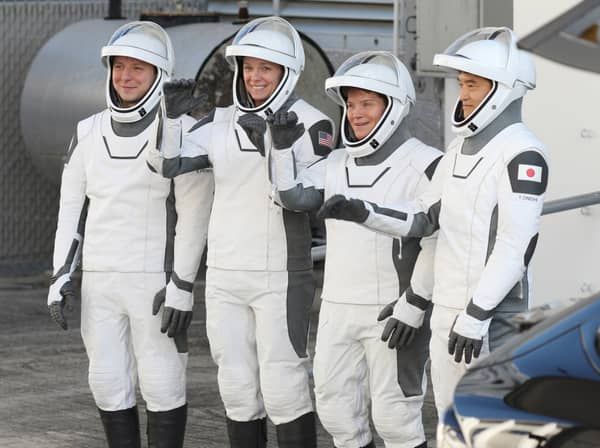
Recent accounts of “attacks” on vessels by orcas off the Iberian peninsula are challenging the way we expect the natural world to behave. Increasing in number since 2020, from northern Portugal to the strait of Gibraltar, these incidents suggest the need for a cetacean scene investigation team. On 4 May, in one of the most extreme events, orcas sank a yacht.
“There were two smaller orcas and one larger,” the skipper Werner Schaufelberger told German magazine Yacht. “The little ones shook the rudder at the back while the big one repeatedly backed up and rammed the boat with full force from the side.”
The word “attack” used in conjunction with animals is a human judgment; their actions are more likely to be defensive. But there is definitely something strange going on. Andrew Sutton, an experienced underwater photographer with whom I work and who is familiar with these particular orca pods, has noted them “doing weird things” in the strait, including “whacking rudders off and annoying fishermen”.
Having witnessed two big intervention episodes last year, he suspects that an increase in vessels may be a factor – not least because the strait is now the most popular route for migrants setting off from Morocco.
The Grupo Trabajo Orca Atlántica (GTOA, or Atlantic Orca Working Group), a highly respected partnership of Spanish and Portuguese scientists, has recorded hundreds of such reports, with 29 incidents this year around the strait alone. They believe that just 15 individuals, of a population of more than 50, are responsible.

Dr Alfredo López Fernandez, of GTOA, told me that they have two hypotheses. One, the orcas “have invented something new and repeat it. This behaviour matches the profile of juveniles.” Or that it is a “response to an adverse situation; one or several individuals have had a bad experience and are trying to stop the boat so as not to repeat it. This behaviour coincides with the profile of adults.”
Either way, it is an astonishing notion. Dr López Fernandez and his team have named, generically, the interacting orcas Gladis (after their original scientific name, Orca gladiator). They suspect an individual, Gladis Blanca, initiated this behaviour after a “critical moment of agony”, perhaps as a result of collison with a vessel; she also has a young daughter, born in 2021. Other Gladis whales have been entangled with fishing gear or suffered lacerations and even amputations. “All this has to make us reflect on the fact that human activities are at the origin of this behaviour.”
The bare bones of Dr López Fernandez’s report evoke a plaintive story. Orca society is matriarchal; it recognises post-menopausal females as the most important members of a pod. Females pass on knowledge of feeding grounds and techniques. In the interventions, “grandmother” orcas have been seen to be observers, as if directing the events.
Luke Rendell of the University of St Andrews has studied orcas extensively in the wild. He said that, while we can only speculate about the causes: “The spread of reaction to past trauma by one individual is plausible … but so are other explanations such as curiosity and play.”
Part of me is secretly excited at this idea of nature fighting back. According to the charity Whale and Dolphin Conservation, at least 174 orcas have died in captivity since 1961, having been forced to swim aimlessly about in overgrown swimming pools without any of the peer interaction that defines them.
The first whale I ever saw was an orca named (by humans) Ramu. He was kept in the dolphinarium at Windsor Safari Park (now Legoland) in the 1970s. As I and my whale-besotted sisters watched Ramu jump through his hoop, we realised that a magnificent animal had been reduced to a circus trick.
I’ve spent 20 years seeing and writing about whales, but I didn’t see an orca again until 2017. Andrew Sutton and I were eight nautical miles off the coast of Sri Lanka, diving with a megapod of sperm whales. Close by, we came upon 30 of them surrounded by two pods of orcas trying to predate the sperm whale calves. When one of the orcas headed directly at us, we quickly got back in the boat.
The orcas were defeated by the massed sperm whales. One pod left the scene. The other reassembled nearby. And we followed, out of curiosity. They began to circle us in the same way they had done with the whales, then head-butted our boat three times.
I was the only one looking over the other side when five of the whales charged at us. It was utterly terrifying. At the last moment they slipped beneath us. As one of the Blue Planet film unit later told me, it is the same technique used by orcas to flip seals off ice floes.
I felt I’d given up all notion of being a “superior” animal. Instead, I was part of this interaction of three cultures: orca, sperm whale and human. Orcas, not us, are probably the most successful mammal on Earth. They’ve been around in their evolved state for 6m years, and are present in every ocean. They have no known predator. Except us.
I’ve no idea if the Iberian orcas are expressing a struggle for survival as we deplete their food sources and pollute their environment. Or just playing with us. But when Ranil Nanayakkara, the scientist with us on the boat, pulled up his underwater microphone after the orcas had gone, he discovered it had been bitten off.
With thanks to Jeroen Hoekendijk
Philip Hoare is the author of several books, including Leviathan, The Sea Inside and Albert and the Whale







